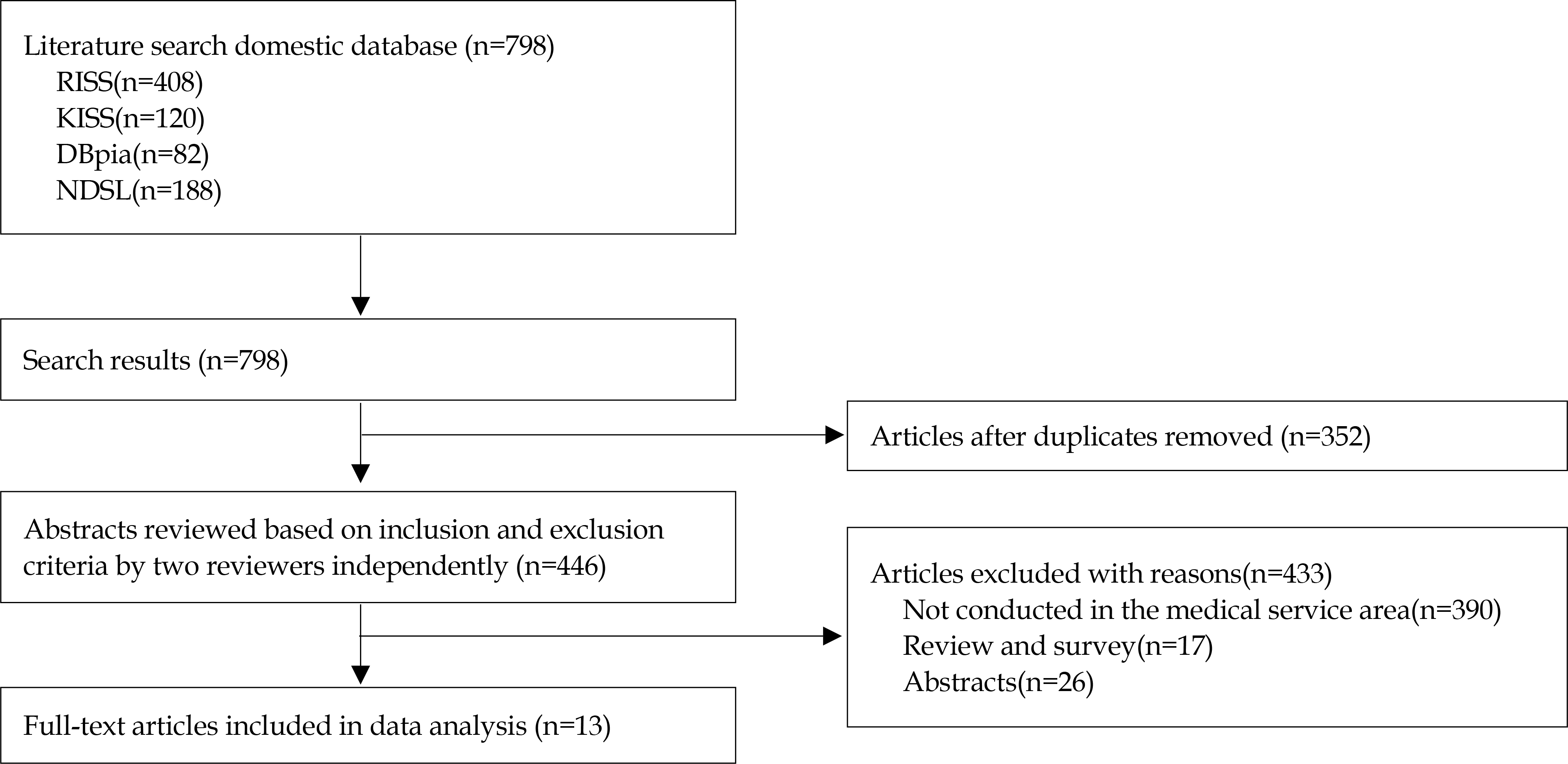Abstract
Purpose
Purpose of this study was to analyze research on the service design process applied to domestic medical service areas.
Methods
A review was made through domestic databases including RISS, KISS, DBpia, and NDSL and for the analysis framework: a medical service classification code which integrated the medical service area and the design fields.
Results
In the healthcare service field there were 9 studies (69.2%) in the medical area, 1 study (7.7%) each in nursing and oriental medicine, and 2 studies (15.4%) in healthcare. According to analysis results based on the medical service classification code, there were 5 studies in prevention and management, 6 studies in curative care, 1 each in rehabilitation and ancillary care. Double diamond process was used in 8 studies.
Conclusion
Service design was applied mainly to the curative care in the domestic medical settings but little research on service design in the long-term nursing care area was identified. As a strategy to improve the quality of nursing service, it is necessary to adopt the service design process for various nursing service areas in Korea.
Go to : 
References
1. Chae YM. The creative society, hospital service innovation implementing patient experience and service design strategies. Korean Journal of Hospital Management. 2014; 19(4):69–78.
2. Korea Institution of Design Promotion. Healthcare design first aid kit [Internet]. Korea Institution of Design Promotion;2013. [cited 2017 January 10] Available from:. http://www.designdb.com/?menuno=790&bbsno=14683&siteno=15&act=view&ztag=rO0ABXQANDxjYWxsIHR5cGU9ImJvYXJkIiBubz0iNTkxIiBza2luPSJwaG90b19iYnMiPjwvY2FsbD4%3D.
3. Kim CS, Nah K. A study on the utilization of open innovation platform co-creation as service design methodology: Focused on the case study of ‘OpenIDEO’ and ‘Quriky’. Journal of Digital Design. 2013; 13(1):333–342.
4. Choi JM, Chun YD. A case study on healthcare service design-focused on service innovation current situation analysis in hospital. Journal of Korean Society of Communication Design. 2014; 23:199–208.
5. Health Insurance Review & Assessment Service. Assessment of 1st patient experience in 2017 [Internet]. Wonju: Health Insurance Review & Assesment Service;2017. [cited 2017 October 16]. Available from:. http://www.hira.or.kr/dummy.do?pgmid=HIRAA020002000000&cmsurl=/cms/inform/01/1352915_27106.html.
6. Design Council. The design process; What is the double diamond? [Internet]. London: Design Council;2015. [cited 2017 November 07]. Available from. http://www.designcouncil.org.uk/news-opinion/design-process-what-double-diamond.
7. Moritz S. Service design-practical access to an evolving field. London: Stefan Moritz;2005. p. 156–159.
8. Son JS. A service design study for medical materials supply system of operating room. [dissertation]. Seoul: Chung-Ang University;2016. p. 1–132.
9. Jeon YO. The development of service design framework for the innovation of Korea's social problems. [dissertation]. Seoul: Hongik University;2016. p. 64–86.
10. Rhi JM. An analysis of current research paradigm for service design in Korea. Journal of Digital Design. 2014; 14(2):417–426.
11. Yoo MH, Kim EK. Case studies on service design-focus on process and methodology. Journal of Communication Design. 2012; 39:31–39.
12. Nam BK. Business models for official development assistance using a service design methodology in health care. [dissertation]. Gimhae: Inje University;2014. p. 48.
13. Designing healthcare services. Proceedings of 2014 Spring Conference of the Korean Society of Adult Nursing; 2014 June 20. Seoul: Korean Society of Adult Nursing;2014.
14. Strategies for nursing management according to the 4th industrial revolution. Proceedings of 2017 Spring Conference of the Korean Academy of Nursing Administration. 2017 June 9. Seoul: Korean Academy of Nursing Administration;2017.
15. Sequist TD, Schneider EC, Anastario M, Odigie EG, Marshall R, Rogers WH, et al. Quality monitoring of physicians: Linking patients' experiences of care to clinical quality and outcomes. Journal of General Internal Medicine. 2008; 23(11):1784–1790.

16. Lin MC, Hughes BL, Katica MK, Christi DZ, Plesk PE. Service design and change of systems: Human-centered approaches to implementing and spreading service design. International Journal of Design. 2011; 5(2):73–86.
17. Lee JH, Kim CJ. Effect of doctor's patient-centered communication on the patient satisfaction and treatment outcomes: Focusing on mediating effect of patient participation. The Journal of the Korea Contents Association. 2013; 13(11):249–260. https://doi.org/10.5392/JKCA.2013.13.11.249.
18. Ministry of the Interior and Safety (KO). Operations manual of Government 3.0 citizens policy design group. Seoul: Ministry of the Interior and Safety;2016.
19. Lee KS, Kim YS, Choi JG, Kim SY. A study on service improvement of department store using service design methodologies. Journal of the Korea Service Management Society. 2015; 16(1):225–243.
20. Heo YJ, Yoo MH. A study on service design process and methods from an innovation perspective-semantic resolution from an empirical study. Journal of Communication Design. 2013; 43:28–37.
Go to : 
Table 1.
General Characteristics of the Research (N=13)
Table 2.
Identification of Research according to Medical Service Classification Code (N=13)
Table 3.
Type of Service Design Process and Method (N=13)




 PDF
PDF ePub
ePub Citation
Citation Print
Print



 XML Download
XML Download